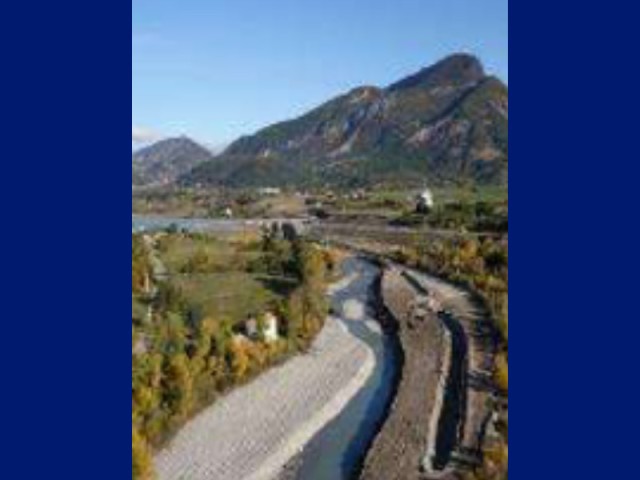Developed since 1987 by EDF R&D in collaboration with other French, European and international organisations, the openTELEMAC system is a set of scientific computation solvers, coupled and parallelized, dedicated to the modelling of free surface environmental hydraulics. It can carry out simulations of flows, sediment transports, waves and water quality. The system has gradually evolved to the notion of hydro-informatics with a set of solvers dealing with large heterogeneous data and solving complex dependent problems. The various simulation components use high-end algorithms based on the finite element or finite volume methods. The ability to study global, regional, or local scale problems by using the same system, makes openTELEMAC a useful tool for assessing the environmental state in the sea, estuaries, coastline, lakes and rivers.
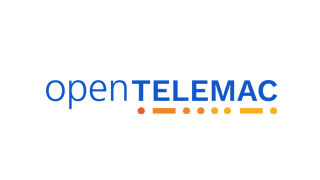
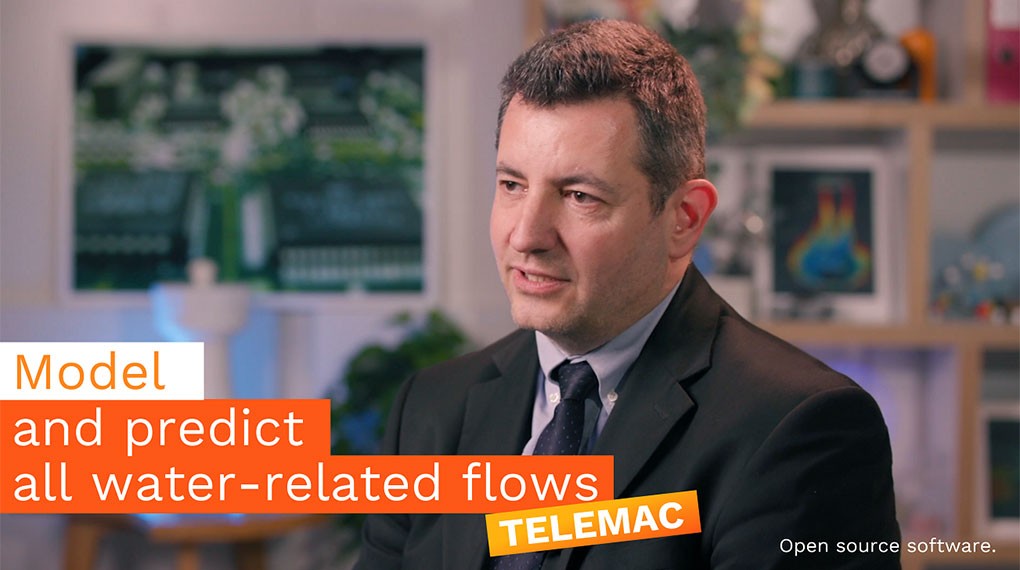
Your browser does not support javascript.
To enable you to access the information, we suggest you view the video in a new tab.
The TELEMAC environment
The openTELEMAC system is composed of the following components, each of which relates to a specific physics, and all of which are coupled together to solve complex problems:
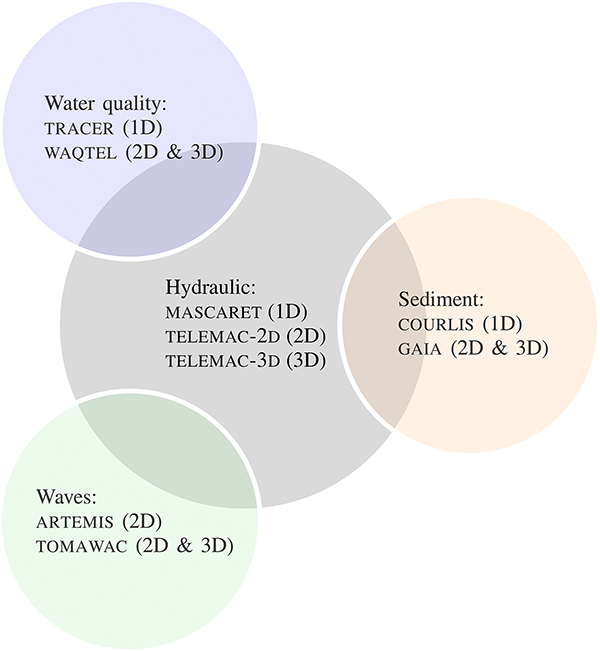
Hydraulic solvers
MASCARET
Modelling of free-surface Shallow Water Equations in 1D (Saint-Venant equations), with non-hydrostatic reconstruction, solved on the basis of finite elements and finite volumes. A model with interconnected compartments makes it possible to take into account inundation zones, relatively isolated from the major riverbed.
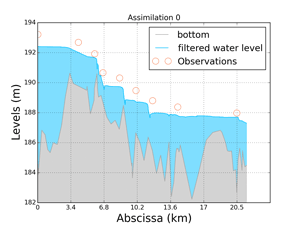
Data assimilation with MASCARET and R on Rhône River (France) reach (F. Zaoui (GitHub - fzao/- MASCARET)) References: [GLZeKA12], [GM02]
TELEMAC-2D
Modelling of the free-surface Shallow Water Equations in 2D (Saint-Venant Equations).
Several turbulence models are available and various other physical terms can be taken into
account like bottom friction, Coriolis and tidal generating forces, interaction with weather (wind, air
pressure, rain, evaporation). It can also solve the advection-diffusion of tracers such as temperature,
salinity or concentrations of material substances.
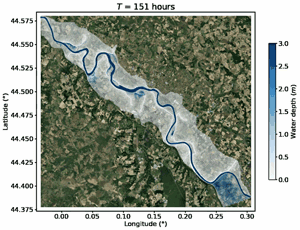
Simulated flood event on Garonne river (France) (J.-P. Travert) References: [Her07], [HPR17], [MDP+11], [MDG+24]
TELEMAC-3D
Modelling hydrodynamics in 3D with free surface through the so-called free-surface non-hydrostatic Navier-Stokes equations. Similarly to TELEMAC-2D, TELEMAC-3D offers several turbulence models, is able to take account of various phenomena or forcings, and can simulate the advection-diffusion of active (driving density varying in space and time) or passive tracers.
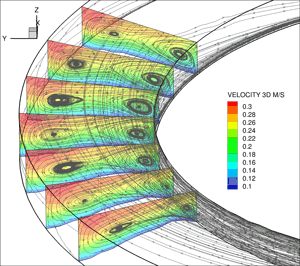
Cross section meander (telemac-3d and gaia coupling) References: [ope23c], [Her07], [MDP+11]

Lock-exchange problem
Wave propagation solvers
ARTEMIS
Modelling waves in coastal and port areas based on the so-called “mild slope equation” initially proposed by Berkhoff (1972) in a framework of linear potential flows (assumption of small amplitude waves or low wave steepness). It is a so-called phase-resolving model, initially formulated for regular waves (i.e. with a fixed wave period or frequency). It can also handle irregular wave fields (characterised by a frequency spectrum of energy) and/or multidirectional waves, by linear superposition of elementary calculations carried out for a given wave frequency and direction. In terms of physical processes, ARTEMIS is suitable for modelling processes affecting wave propagation over variable bottoms in coastal areas (refraction, shoaling), interactions with obstacles or coastal/port structures (reflection, diffraction), as well as energy dissipation processes due to bottom friction and/or surf-breaking in shallow water. The effects of an ambient current (due to the tide, for example) can also be taken into account. ARTEMIS is particularly well suited to studies of wave penetration and agitation in ports, harbour basins, seawater intake or discharge channels. It can also be used to study the risks of resonance (seiches) in these basins.
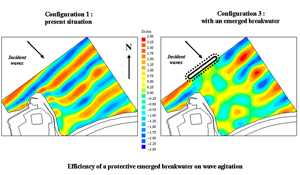
Wave simulation over the Alexandria lighthouse archaeological site Reference: [Ael97]
TOMAWAC
TOMAWAC is a third generation spectral wave model for sea states evolution from the oceanic to the coastal scale. It models the spatial and temporal evolution of the directional spectrum of wave energy, providing a high-level description of the sea state. TOMAWAC can be used to model a large number of physical processes, including the generation of waves by the wind, their propagation over very large distances on an oceanic scale, and the effects of water depth variations as waves approach the shore (refraction due to variations in bathymetry and/or an ambient current field), the many processes that dissipate wave energy (white-capping, wave breaking due to bathymetry, bottom friction, attenuation by porous media or vegetation) or redistribute wave energy within the spectrum via non-linear transfers between wave frequencies (among 4 or 3 waves). The wind fields supplied as input forcing data, as well as the characteristics of the marine environment (sea level, ambient currents) can, in the general case, be spatially and temporally variable. TOMAWAC can be used for several types of application, including wave climate simulation based on wind fields (from meteorological reanalyses or atmospheric forecast models), on the scale of a few days (storm) or several decades (wave hindcast database), wave propagation studies in coastal areas, by transferring sets of known wave conditions off a site to the coast.
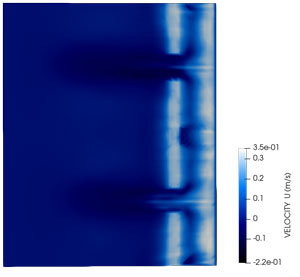
Rip current : The coupling between TOMAWAC and TELEMAC-3D allows to simulate the rip current induced by the waves breaking. References: [BMB96], [Ben05], [RJAJL18], [TPSB13], [TWB22], [GRBF10], [GRBB11], [LMB+14], [VBVT23], [BMB97], [ABMG98], [JGRBV14]
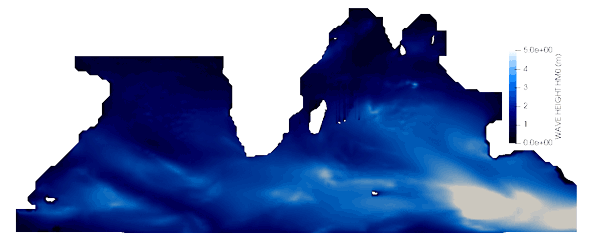
Simulated wave height in Indian Ocean from 01/01/2000 to 07/01/2000
Sediment transport solvers
COURLIS
COURLIS modelling sediment transport in rivers and reservoirs where the flows can be considered as 1D. Evolution of riverbeds due to bedload transport is classically modelled by coupling the Shallow-Water equations for hydrodynamic processes (solved in the MASCARET solver) and the Exner equation for bedload mechanisms. COURLIS manages cohesive and non-cohesive sediment transport by suspension.
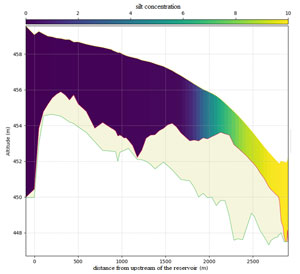
Longitudinal profil of silt concentration after a reservoir drawdown. References: [SUV+18], [CMT+22], [LTMT+22]
GAIA
GAIA solves sediment transport and morphological evolution problems in rivers, coastal seas, estuaries and reservoirs. By a clear treatment of sedimentary processes that happen in the water column, in the bed structure, and at the water–bed interface. The module GAIA efficiently manages the spatial and temporal variability of sediment size classes, the different properties for cohesive and non-cohesive sediments, and the transport modes (bedload and suspension) for two- and three dimensions.
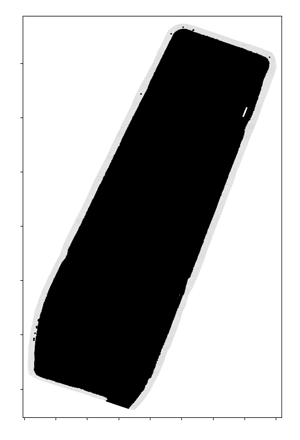
Sediment concentration in an idealized reservoir. References: [TBD+23, SFT+17, RST22, CTC+20, HLJ23, LBM+, Bro]
Water quality solvers
TRACER
TRACER modelling solute transport processes, consisting of advection, dispersion and mass reduction/generation by physical, chemical and biological mechanisms. TRACER is the transport and water quality module of the 1D free surface code MASCARET. TRACER simulates the evolution of several coupled tracers without retroaction on the flow with respect to hydraulic conditions, boundary conditions, external sources and biochemical interactions between tracers.
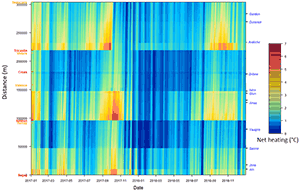
Simulation of water net heating along the Rhône river due to the operation of nuclear power utilities (from bottom to top: from upstream to downstream; from left to right: from 1st January to 31st December 2017; more details). References: [GEKAZ+12], [EAZ15]
KHIONE
KHIONE modelling of suspended frazil ice and ice cover, based on an advanced heat balance, taking into account interactions between water, air and frazil concentration, freezing processes and ice cover formation, as well as the effects of ice cover on hydrodynamics or on submerged structures such as clogging on trash racks.
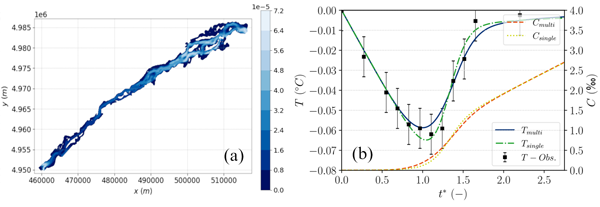
Simulation of frazil concentration in the Saint Lawrence river (a) from [ope23b] and supercooling validation with Carstens experiments (b) from [SGM23]. References: [BHSA18], [STEM20], [SGM23], [ope23a]
WAQTEL
WAQTEL modelling of biochemical and thermal processes within water bodies in the natural environment. This component includes a complete model of heat exchange with the atmosphere. It includes processes related to the oxygen, algae, ammonia and phosphate cycles, as well as biomass and micro-pollutants processes in suspension or dissolved. WAQTEL is coupled with the 2 codes TELEMAC-2D and TELEMAC-3D. WAQTEL module was built from the processes implemented in TRACER and extended to 2D and 3D for most of the processes. A coupling to the AED2 library is also available for more advanced water quality simulations.
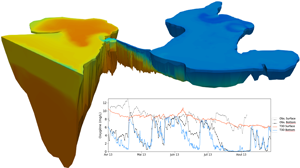
Oxygen evolution in Lagoon [JBPVH21] References: [ope23d], [HBH13]
The environment around openTELEMAC
Surrounding the openTELEMAC system solvers and also distributed as open source codes, an ensemble of scripts entirely written in Python have been developed to allow the environmental modeling system to meet the challenges of complex real-world problems. In this framework, distributed Application Programming Interface (API) of the openTELEMAC system with a Python overlay has been developed. This Python wrapping of openTELEMAC system API constitutes a package called TELAPY distributed in the official version of the hydro-informatic system.
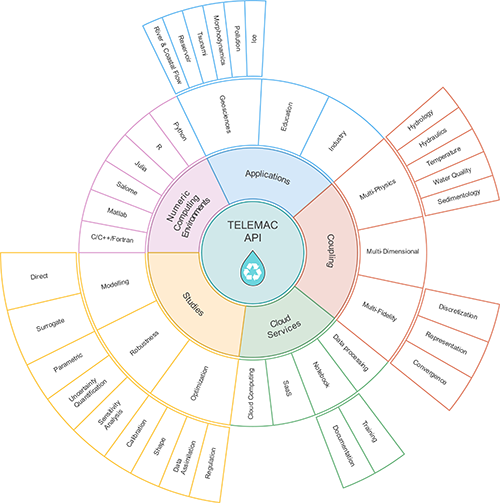
Ecosystem of openTELEMAC API. References: [AFF+19], [GAZ22]
Proceedings for more insight into the capacities of openTELEMAC
References :
- [ABMG98] D. Aelbrecht, M. Benoit, F Marcos, and G. Goasguen. Prediction of offshore and nearshore storm waves using a third generation spectral wave model. In Proc 8th Int. Offshore and Polar Eng. Conf. (ISOPE’1998), Montreal, pages 71–76, 1998.
- [Ael97] D. Aelbrecht. ARTEMIS 3.0: a finite element model for predicting wave agitation in coastal areas and harbours including dissipation. In Proc. Int. Conf. Computer Modelling of Seas and Coastal Regions III. Edited by J.R. Acinas and C.A. Brebbia. WIT Transactions on The Built Environment, volume 30, pages 343–352, 1997.
- [AFF+19] Yoann Audouin, Jacques Fontaine, Thierry Fouquet, Cédric Goeury, Agnès Leroy, Chi-Tuan Pham, Frank Souillé, Florian Taccone, Luc Duron, Mehdi-Pierre Daou, and Matthieu Sécher. A new python3 module for telemac-mascaret dedicated to posttreatment: Postel. In Proceedings of the XXVIth TELEMAC-MASCARET User Conference, 15th to 17th October 2019, Toulouse, 2019.
- [Ben05] M. Benoit. Evaluation of methods to compute the non-linear quadruplet interactions for deep-water wave spectra. In 5th Int. Symp. on Ocean Wave Measurement and Analysis
- (WAVES 2005), number 52, 2005.
- [BHSA18] S. E. Bourban, F. Huang, H.T. Shen, and R. Ata. Introducing khione - (eulerian) part i of the ice modelling component of telemac. Online proceedings of the papers submitted to the 2018 TELEMAC-MASCARET User Conference, 2018.
- [BMB96] M. Benoit, F. Marcos, and F. Becq. Development of a third generation shallow water wave model with unstructured spatial meshing. In 25th Int. Conf. on Coastal Eng., pages 465–478, Sep. 1996.
- [BMB97] M Benoit, F. Marcos, and F. Becq. Tomawac : a prediction model for offshore and nearshore storm waves. In 27th Congress of the International Association for Hydraulic Research, San-Francisco (California, USA), 1997.
- [CMT+22] Nicolas Claude, Lucie Mesquita, Florent Taccone, Magali Jodeau, Minh-Hoang Le, Matthieu Secher, Lauréat Tchicou Midou, and Eric Valette. 1d numerical modelling of the longitudinal profile evolution of riverbeds and reservoirs: application of courlis bedload on a real case. In Proceedings of the XXVIIIth TELEMAC User Conference 18-19 October 2022, 2022.
- [CTC+20] Florian Cordier, Pablo Tassi, Nicolas Claude, Alessandra Crosato, Stephane Rodrigues, and Damien Pham Van Bang. Bar pattern and sediment sorting in a channel contraction/expansion area: Application to the Loire river at Brehemont (France). Advances in Water Resources, 140:103580, 2020.
- [EAZ15] Kamal El Kadi Abderrezzak, Riadh Ata, and Fabrice Zaoui. One-dimensional numerical modelling of solute transport in streams: The role of longitudinal dispersion coefficient. Journal of Hydrology, 527:978–989, 2015.
- [GAZ22] Cédric Goeury, Yoann Audouin, and Fabrice Zaoui. Interoperability and computational framework for simulating open channel hydraulics: Application to sensitivity analysis and calibration of gironde estuary model. Environmental Modelling & Software, 148:105243, 2022.
- [GEKAZ+12] Julian Gille, K. El Kadi Abderrezzak, F. Zaoui, Marc Robin, and Stephan Gaillard. A one dimensional (1-D) numerical modelling of pesticide transfer through the wetland drainage channels of Breton-Vendéen marsh (west coast of France). In Proceedings of the XIXth TELEMAC-MASCARET User Conference, Oxford, United Kingdom, October 2012.
- [GLZeKA12] Nicole Goutal, J.-M Lacombe, F. Zaoui, and Kamal el Kadi Abderrezzak. Mascaret: A 1-d open-source software for flow hydrodynamic and water quality in open channel networks. River Flow 2012 - Proceedings of the International Conference on Fluvial Hydraulics, 2:1169–1174, 01 2012.
- [GM02] N. Goutal and F. Maurel. A finite volume solver for 1d shallow-water equations applied to an actual river. International Journal for Numerical Methods in Fluids, 38(1):1–19, 2002.
- [GRBB11] E. Gagnaire-Renou, M. Benoit, and S. Badulin. On weakly turbulent scaling of wind sea in simulations of fetch-limited growth. Journal of Fluid Mechanics, (669):178–213, 2011.
- [GRBF10] E. Gagnaire-Renou, M. Benoit, and P. Forget. Ocean wave spectrum properties as derived from quasi-exact computations of nonlinear wave-wave interactions. Journal of Geophysical Research C (Oceans), (115), 2010.
- [HBH13] M. R. Hipsey, L. C. Bruce, and D. P. Hamilton. Aquatic ecodynamics (aed) model library. science manual draft v4, October 2013.
- [Her07] J.-M. Hervouet. Hydrodynamics of Free Surface Flows: Modelling with the Finite Element Method. John Wiley & Sons, Ltd, 2007.
- [HLJ23] Hanna Haddad, Cédric Legout, and Magali Jodeau. Spatial variability of erodibility of fine sediments deposited in gravel river beds: from field measurements to 2d numerical models. Journal of Soils and Sediments, 23(10):3602–3619, 2023.
- [HPR17] J.-M. Hervouet, S. Pavan, and M. Ricchiuto. Residual distribution advection schemes in telemac. Technical Report Research Report RR-9087, INRIA Bordeaux Sud-Ouest, 2017. hal-01571827v2.
- [JBPVH21] Elisabeth Justin-Brochet, Chi-Tûan Pham, and Javier Vidal-Hurtado. Recent improvements for the berre lagoon modelling with telemac-3d. In W. Alexander and Breugem, Lesley Frederickx, Theofano Koutrouveli, Kai Chu, Rohit Kulkarni, and Boudewijn Decrop, editors, Proceedings of the papers submitted to the 2020 TELEMAC-MASCARET User Conference October 2021, page 33, Antwerp, 2021. International Marine and Dredging Consultants (IMDC).
- [JGRBV14] A. Joly, E. Gagnaire-Renou, M. Benoit, and D. Violeau. Numerical modelling of wind waves on a river flood plain. In 3rd IAHR Europe Congress, Book of Proceedings, Porto (Portugal), 2014.
- [LBM+] Kim-Jehanne Lupinski, Guillaume Brousse, Raphaël Maurin, Pierre Sagnes, Dominique Courret, Florian Cordier, Laurent Lacaze, and Magali Jodeau. Hybrid modeling for in situ artificial fish spawning ground stabilization. River Research and Applications, n/a(n/a).
- [LMB+14] A. Laugel, M. Menendez, M. Benoit, G. Mattarolo, and F. Mendez. Wave climate projections along the french coastline: dynamical versus statistical downscaling methods. Ocean Modelling, (84), 2014.
- [LTMT+22] Minh-Hoang Le, Lauréat Tchicou Midou, Florent Taccone, Magali Jodeau, Nicolas Claude, Lucie Mesquita, Matthieu Secher, and Eric Valette. Evolution of river crosssections due to bedload transport: a new model implemented in the 1d sediment module courlis. In Proceedings of the XXVIIIth TELEMAC User Conference 18-19 October 2022, 2022.
- [MDG+24] A. Moussaddak, A. Decoene, C. Goeury, A. Ponçot, and T. Taddei. A review of telemac-2d numerical schemes for modelling two-dimensional free surface flows. In Online proceedings of the papers submitted to the 2024 TELEMAC-MASCARET User Conference, 2024.
- [MDP+11] C. Moulinec, C. Denis, C.-T. Pham, D. Rougé, J.-M. Hervouet, E. Razafindrakoto, R.W. Barber, D.R. Emerson, and X.-J. Gu. Telemac: An efficient hydrodynamics suite for massively parallel architectures. Computers & Fluids, 51:30–34, 2011.
- [ope23a] Khione user manual. https://gitlab.pam-retd.fr/otm/telemac-mascaret/-/raw/v8p5r0/documentat…, 2023. Version v8p5.
- [ope23b] Khione validation manual. https://gitlab.pam-retd.fr/otm/telemac-mascaret/-/raw/v8p5r0/documentat…, 2023. Version v8p5.
- [ope23c] Telemac-3d theory guide. https://gitlab.pam-retd.fr/otm/telemac-mascaret/-raw/v8p5r0/documentati…, 2023. Version v8p5.
- [ope23d] Waqtel theory guide. https://gitlab.pam-retd.fr/otm/telemac-mascaret/-/raw/v8p5r0/documentat…, 2023. Version v8p5.
- [RJAJL18] C Raoult, A. Joly, M. Andreevsky, and A. Joly-Laugel. Anemoc-3: Improving the anemoc-2 sea state database by adding tide effects. In Actes des 16`emes Journées de l’Hydrodynamique, pages 114–130, 2018.
- [RST22] Rajae Rtimi, Aldo Sottolichio, and Pablo Tassi. The Rance tidal power station: Toward a better understanding of sediment dynamics in response to power generation. Renewable Energy, 201:323–343, 2022.
- [SFT+17] Pablo Santoro, Monica Fossati, Pablo Tassi, Nicolas Huybrechts, Damien Pham Van Bang, and J.C. Ismael Piedra-Cueva. A coupled wave-current-sediment transport model for an estuarine system: Application to the Rio de la Plata and Montevideo Bay. Applied Mathematical Modelling, 52:107–130, 2017.
- [SGM23] F. Souillé, C. Goeury, and R.-S. Mouradi. Uncertainty analysis of single- and multiplesize-class frazil ice models. The Cryosphere, 17(4):1645–1674, 2023.
- [STEM20] Fabien Souillé, Florent Taccone, and Chaymae El Mertahi. A multi-class frazil ice model for shallow water flows. Online proceedings of the papers submitted to the 2020 TELEMAC-MASCARET User Conference, pages 122–129, 2020.
- [SUV+18] Matthieu Secher, Philippe Ung, Eric Valette, Magali Jodeau, and Nicole Goutal. Courlis: a 1d suspension and bedload code. E3S Web of Conferences, 40:05038, 01 2018.
- [TBD+23] Pablo Tassi, Thomas Benson, Matthieu Delinares, Jacques Fontaine, Nicolas Huybrechts, Rebekka Kopmann, Sara Pavan, Chi-Tuan Pham, Florent Taccone, and Regis Walther. Gaia - a unified framework for sediment transport and bed evolution in rivers, coastal seas and transitional waters in the telemac-mascaret modelling system. Environmental Modelling & Software, 159:105544, 2023.
- [TPSB13] M.J. Teles, A.A. Pires Silva, and M. Benoit. Three dimensional modelling of wavecurrent interactions in the coastal zone with a fully coupled system. In Proc. 7th Int. Conf. on Coastal Dynamics. 24-28 June 2013, Arcachon (France)., 2013.
- [TWB22] M.J. Teles, M. Weiss, and M. Benoit. Assessment of the anemoc-3 sea state hindcast database for modelling a series of energetic winter storms along the french coast. In Journées Nationales Génie Côtier - Génie Civil, 2022.
- [VBVT23] A. Villefer, M. Benoit, D. Violeau, and M. Teles. Spectral wave modelling of bimodal sea states at laboratory and coastal scales. Ocean Modelling, (183), 2023.


